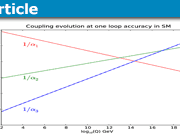Exploring the Energies in the Large Hadron Collider
The Large Hadron Collider has produced collisions at 7 TeV. For collisions at 7 TeV, protons need to be ‘ramped’ to 3.5 TeV, the proton has a mass of 1.6726e−27 kg which, according to mass–energy equivalence (E=mc^2), is 938.272 MeV where 1 eV= 1.6022e−19 Joules. The proton will be accelerated to 0.999999964c (11,103.4 revolutions of the LHC per second) which means the following relativistic equation can be used-
E_T= γmc^2
where E_T is energy total and γ=1/√(1-(v^2/c^2)). γ is the Lorentz factor and tells us how much the energy of an object increases due to kinetic energy.
which produces a total of E_T=3.4967 TeV
This is also supported by Einstein’s more complete mass-energy equation-
E_T=√(m^2c^4+p^2c^2)
where p is momentum and is expressed p=γmv (or p=h/λ in the case of light where h is Planck’s constant and λ is wavelength).
which produces a total of E_T=3.4959 TeV
CERN hopes to conduct collisions at 14 TeV which would require speeds of up to 0.999999991c (1-8.98e−9c)
Another interesting aspect is the effect on the time for the proton. The relativistic equation for time dilation is-
τ=t/γ
where τ is proper time relative to the proton and t is coordinate time, or time according to a (relatively) static frame. In this case, at energies of 3.5 Tev, the time dilation for the proton is 2.6833e−4 which means for every hour that passes outside the accelerator, only 1 second passes for the proton (0.966 seconds), at 7 TeV, only ½ a second would pass (0.483 seconds). The application of the Lorentz factor to time dilation can be supported by looking at a basic spacetime metric derived from Minkowski spacetime, accordingly-
c^2dτ^2=c^2dt^2-dx^2
again, where τ is the proper time of the moving object, t is coordinate time and x is the distance covered. x can be rewritten as-
dx^2=v^2dt^2
where v=dx/dt (i.e. velocity is m/s), v^2=dx^2/dt^2 which can be rewritten as above. The spacetime metric can now be written as-
c^2dτ^2=c^2dt^2-v^2dt^2
dτ^2=(c^2dt^2-v^2dt^2)/c^2
dτ=√((c^2dt^2-v^2dt^2)/c^2)
=√(dt^2(1-v^2/c^2))
= dt√(1-v^2/c^2)
which is equivalent to τ=t/γ.
Time dilation for relativistic sub-atomic particles is also supported by muons (high energy leptons) which enter the atmosphere from space, according to our clocks, the muon should decay at 660 m into the atmosphere based on a life span of 2.2e−6 seconds and a velocity of 0.9996678c but due to time dilation (τ=0.02577), muons survive the flight to earth’s surface and can penetrate tens of meters of rock before decaying.
Early life spent working and studying in York UK, 3 year architecture degree at Oxford polytechnic, 2 year architecture diploma at Oxford polytechnic, part-time in US. Worked in both York and London within architectural profession.










Leave a Reply
Want to join the discussion?Feel free to contribute!